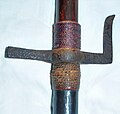Blade catcher
Blade catcher is a device on various protective and attack weapons. The blade catchers can be found in various shapes and positions on shields and blade weapons . In all cases they serve to catch and hold an opposing blade. The purpose here is to interrupt the opponent's attack in order to carry out a counterattack ( riposte ) yourself .
to form
Shields
The razors can often be found on fencing shields from Italy from the 16th century. They are attached to the shields in different ways. They are available as flat strips that are riveted horizontally and on bars as spacers to the sign surface. These are usually circular, adapted to the curve of the shield, placed in the middle or close to the edge of the shield. Blade-like with deep incisions or simple, hook-shaped blade catchers can be attached in the middle of the shield boss.
Vessels of bladed weapons
In almost all versions of the rapier and rapier baskets, the intertwined parrying elements not only protect the guide hand, but also serve as a blade catcher. The elaborate shapes of the baskets make it easier to jam the opponent's blade, which blocks and holds it and enables a counterattack with the parrying dagger held in the other hand .
While straight crossguards are used to intercept and deflect the opponent's blade, the downwardly curved crossguards allow you to pinch the opponent's blade by rotating your own weapon.
With bells vessels of the edge can be bent ( crushing margin ), making him the effective blade catcher. The often decorative openings on the guard plate can also be used for this purpose.
Parrying daggers
Many parrying daggers , also known as the "left hand", are specially designed to catch the opponent's blade. In addition to the possibilities of catching with the vessel, some are equipped with special devices for this purpose. One form is the jumping blade dagger . Its hinged blades serve as a blade catcher, where the blade can be jammed by simply turning your hand. Another type are cuts on the base of the blade that run parallel to the blade from the hand guard. Another version is the so-called epee breaker with deep incisions in the blade.
Polearms
Some versions of the glaive have an upward hook on the back, which serves as a blade catcher. Spring blades like the parrying dagger are rarely found on polearms, but they serve the same purposes there. In Japan, the counterpart to the European razor catchers is often found on polearms ( yari ). There it is called "Hadome".
Individual evidence
- ↑ Seifert 1981, p. 34
- ↑ Boeheim 1890, pp. 188-189
- ↑ Lewerken 1989, p 125
- ↑ Oakeshott 1980, p. 168
- ↑ Lewerken 1989, p 126
- ↑ Lewerken 1989, pp. 125-126
- ↑ Boeheim 1890, pp. 342-342
- ↑ Boeheim 1890, p. 380
- ↑ Lewerken 1989, pp. 134, 277-278
literature
- August Friedrich Demmin : The weapons of war in their historical development - from the oldest times to the present , Verlag Friesenhahn, Leipzig 1893, ( digitized at the Internet Archive ) page 566 Figure 46 u. 46 bis, page 568 Figure 50, page 570 Figure 66
- Heinz Werner Lewerken: Combination weapons of the 15th – 19th centuries Century. Military publishing house of the German Democratic Republic , 1989, ISBN 3327005168
- Wendelin Boeheim : Handbook of the armory. 1890, ( digitized at the Internet Archive )
- Gerhard Seifert: Technical terms of edged weapons: German abc of the European bare weapons; (Cut, thrust, hit and hand weapons) , self-published, 1981
- Ewart Oakeshott : European Weapons and Armor: From the Renaissance to the Industrial Revolution , The Lutterworth Press, 1980









